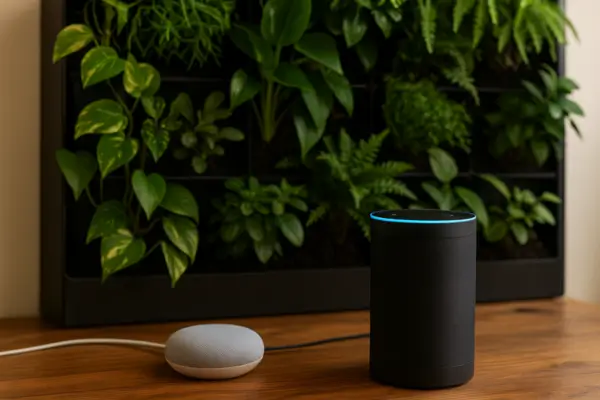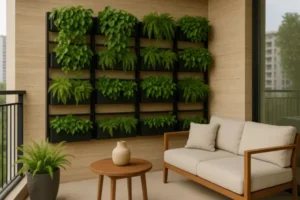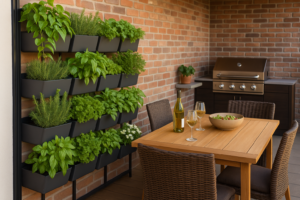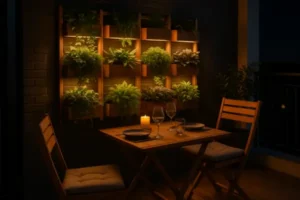Vertical gardens and smart homes come together to create a connected, efficient, and vibrant living space. It’s a way to bring nature and technology together, allowing your home to meet your needs while remaining beautifully green.
Imagine asking Alexa how your garden is doing and hearing that the moisture levels are balanced, the grow lights are on schedule, and the watering cycle went perfectly. Everything flows seamlessly, without the need to manually check or adjust.
We’ll walk you through how to set up this connection step by step. From choosing the right devices to creating helpful routines, you’ll learn how vertical gardens and smart homes can work together to simplify your day and brighten your space.
How Do Vertical Gardens and Smart Homes Work Together?
At first glance, vertical gardens and smart homes might seem like two separate trends—one about nature, the other about technology. But when they’re combined, they create a seamless living experience that blends beauty, automation, and practicality.
What exactly connects the two?
The connection lies in automation and real-time feedback. Smart home systems like Alexa and Google Home act as control hubs, managing the devices that keep a vertical garden running smoothly. These systems can monitor conditions, adjust lighting, trigger watering schedules, and even respond to your voice commands.
Let’s say your garden is in a low-light area. You can set smart grow lights to turn on automatically at specific times. Pair them with a smart plug or a scheduling routine through Alexa, and you never have to worry about forgetting them.
Add a soil moisture sensor to the mix, and it’ll water itself only when the plants really need it.
Which devices are commonly used?
Here’s where smart gardens get practical. People typically start with a few core items that make automation simple:
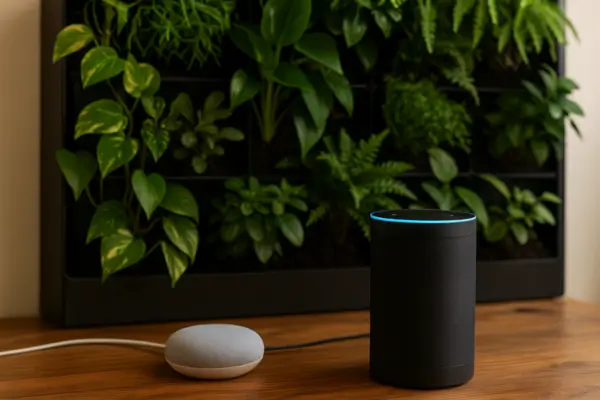
- Smart plugs and switches for powering LED grow lights or water pumps
- Wi-Fi-enabled irrigation systems that activate based on custom routines or voice prompts
- Soil moisture and temperature sensors that send alerts or trigger watering
- Smart speakers (like Echo or Nest) to serve as the command center for it all
The beauty is that many of these devices are modular and compatible with systems people already have in their homes.
Why is this becoming more popular?
A lot of it comes down to ease and lifestyle. People want homes that do more with less input. A vertical garden that manages itself—at least partly—removes one more task from your list. It also brings a sense of rhythm and responsiveness to the space.
And for people who live in smaller apartments or urban areas, combining smart tech with greenery helps make the most out of limited square footage. It’s not just decoration—it’s function, and it’s personalized.
What Are the First Steps to Build a Smart Vertical Garden at Home?
If you’re new to combining vertical gardens and smart homes, it’s normal to wonder where to begin. But the process is more accessible than it seems. You don’t need a background in tech—or a big investment—to create a space that works beautifully and responds to your routine.
Start by choosing the right garden structure for your space. That could be a vertical pocket panel, a modular system for your balcony, or even stacked planters near the kitchen. Think about sunlight, airflow, and how easy it is to reach the plants for basic care. These small choices make a big difference later on.
With the setup in place, you can begin integrating smart features one step at a time. A great way to start is by automating a single action:
- For watering: use a smart plug with a timer or a Wi-Fi irrigation controller.
- For lighting: add grow lights connected to Alexa or Google Home for scheduled or voice-controlled use.
From there, expand at your own pace. Maybe later you’ll add a moisture sensor or set routines for different seasons. What matters is starting with one thing that simplifies your day—and building from there.
Creating a smart garden is not a race. It’s something that grows with you. As you adjust and experiment, you’ll find the rhythm that works best for your space and your lifestyle.
How Can You Automate a Vertical Garden Using Alexa or Google Home?
When people think of smart homes, they often imagine adjusting lights or playing music. But vertical gardens can fit into this ecosystem just as easily—with automation that’s surprisingly flexible and practical.
The starting point is understanding what your garden needs regularly. Most vertical gardens require three things: lighting, hydration, and basic monitoring. Each of these can be automated using common smart devices that work with voice assistants.
Let’s take watering, for example. You can connect a water pump or irrigation system to a smart plug. Then, using your Alexa app or Google Home routines, schedule it to turn on for a few minutes each morning.
If your system includes a moisture sensor, you can set a condition: water only when the soil is below a certain threshold. That way, you’re not guessing—you’re responding to real-time data.
For lighting, grow lights can be programmed based on the plants’ needs and natural daylight hours. Voice assistants let you group devices by location, so you can say something like, “Turn on garden lights,” and everything activates at once.
As for monitoring, smart sensors placed in the soil or near the foliage can detect temperature, humidity, or light levels. Some send notifications to your phone. Others work directly with Alexa routines or IFTTT applets to trigger actions—like turning on a fan if it gets too hot near the plants.
One of the most useful tools is voice control. Once routines are created, you can simply say:
- “Alexa, check the garden.”
- “Hey Google, water the vertical garden.”
- “Alexa, turn off the grow lights.”
This hands-free interaction becomes part of your daily routine. It’s not just convenient—it’s also satisfying to see your plants thrive with a little help from technology.
What Smart Devices Work Best for Vertical Gardens?
When it comes to vertical gardens and smart homes, the right devices make all the difference. Some tools are simple and game-changing. Others might sound impressive but bring more complexity than value. The key is to choose based on your space, your rhythm, and what really helps your plants thrive.
A great starting point is the smart plug. Think of it as a bridge between everyday devices—like grow lights or small pumps—and your voice assistant.
You can turn things on and off remotely or set up schedules through Alexa or Google Home. They’re affordable, easy to install, and make a big impact from day one.
Another essential is the smart irrigation controller. These are especially useful if you travel often or prefer not to worry about watering. Some models adjust automatically based on weather forecasts, while others activate through voice commands. They give your garden consistency, even when your schedule changes.
Here’s a simple list of what to consider adding:
- Smart LED grow lights – perfect for balconies or kitchens with limited sun. Many can be dimmed or timed via app or assistant.
- Soil moisture sensors – track real-time hydration levels and help prevent overwatering or dry spells.
- Indoor climate monitors – show you temperature and humidity levels so you can tweak your environment if needed.
These tools don’t need to be added all at once. Start with what makes the most sense for your routine. Over time, as your vertical garden grows, you can expand your setup to fit naturally into your day.
A quick tip before buying: check device compatibility with Alexa, Google Home, or platforms like IFTTT. That ensures everything connects smoothly. Sticking to one ecosystem often means fewer surprises and an easier setup overall.
What Are the Real-Life Benefits of Combining Vertical Gardens and Smart Homes?
Combining vertical gardens and smart homes brings more than just beauty to your space—it adds rhythm to your day. Simple tasks become automatic. Time feels more productive. And your home starts responding to you, instead of the other way around.
One of the most valuable shifts is how consistent your plant care becomes. With a smart setup, your garden waters itself, lights adjust on schedule, and you can monitor everything at a glance. The guesswork disappears, and your plants thrive with regularity.
Here’s what people often enjoy the most:
- Remote access: Whether you’re at home or away, you can manage your garden from your phone or by voice.
- Customized routines: Set schedules that match your life—sunset lighting, weekly watering, or seasonal changes.
- Less stress: No need to remember every detail. Your system helps you stay on track, without reminders.
Another great point is how flexible everything can be. If you’re just starting out, a few smart plugs or a basic timer already make a difference. Over time, you can expand with sensors, lighting zones, or even routines that react to weather conditions.
And there’s something else people often mention: a quiet satisfaction. Watching your plants respond to a system you designed brings a sense of connection. You notice the growth. You feel the rhythm. The garden becomes part of your space—alive and quietly interactive.
Everything stays open to change. As your lifestyle evolves or your space grows, so does your setup. That’s the beauty of linking vertical gardens and smart homes—they adapt with you, one smart detail at a time.
How to Troubleshoot Common Issues in a Smart Vertical Garden Setup
Even the most well-planned setups can face a few hiccups. With vertical gardens and smart homes, the key is staying calm and knowing how to reset things without overthinking. Most problems are easy to handle once you spot where the issue starts.
A common one is device connectivity. If your smart plug or sensor isn’t responding, it’s often related to Wi-Fi. Check if the signal reaches your garden space—especially if it’s on a balcony or in a corner far from the router. A Wi-Fi extender or moving the router a bit closer usually solves it.
Another area to check is your automation routines. If watering or lighting doesn’t follow the schedule, take a look at your voice assistant app. Sometimes updates reset or rename routines without notice. Go into the settings and make sure your garden-related commands are still active and clearly labeled.
Here’s a quick list of things that help when issues come up:
- Check device names: Avoid duplicates like two “garden lights”—use specific names to help Alexa or Google respond properly.
- Clean your sensors: Dirt or mineral buildup can affect readings. Wipe them gently and place them deeper in the soil for more accurate data.
- Watch for overwatering: If leaves look soft or yellow, reduce the schedule or add a sensor that controls when watering happens.
And if something still doesn’t seem right, going back to basics usually helps. Unplug the device, restart the app, and walk through the setup again slowly. These systems are made to be user-friendly, and sometimes a fresh start is all it takes to get things working again.
How Voice-Controlled Gardens Can Change Your Daily Routine in Unexpected Ways
Using voice commands in your garden might feel like a novelty at first—but it quickly becomes something more. Talking to your vertical garden through Alexa or Google Home starts to feel like part of the flow of your day. And over time, those small interactions begin to shape how you move through your home.
Here are a few ways voice-controlled gardens quietly shift your routine:
- You start mornings by saying, “Turn on the garden lights,” while your coffee brews.
- You check in with your plants by asking for moisture levels instead of poking at the soil.
- You say, “Water the herbs,” while prepping lunch, and it just happens.
- You close the day with a soft command that sets the mood: lights dim, music plays, garden glows.
These little habits turn into moments of connection. Saying things out loud brings attention to your plants in a way that feels natural. You start noticing their colors, growth, and presence more often—even though automation handles the work.
For families, voice commands become part of daily learning. Kids love helping out when it feels like a game: “Who wants to ask Google to water the strawberries?” It creates a rhythm without pressure. And for anyone building new routines, it’s a gentle way to stay consistent.
Some people take it further, creating custom phrases that control multiple elements at once. A single sentence can activate watering, adjust lighting, and even play your favorite playlist. Suddenly, gardening becomes part of the atmosphere—woven into how you experience your space.
At the end of the day, voice-controlled gardens aren’t just about saving time. They invite you to engage differently—with more ease, more awareness, and a stronger sense that your home is working with you.
A Practical Routine You Can Set Up Today with Your Smart Vertical Garden
One of the easiest ways to feel the real benefit of combining vertical gardens and smart homes is by building a routine that actually fits your day. It doesn’t need to be complex—it just needs to work without effort.
Picture a vertical garden near your kitchen window or on a sunny balcony. You connect a smart plug to the grow lights, set up a Wi-Fi irrigation timer, and place a moisture sensor in one of the planters. With just these tools, you can create a simple daily flow using your voice assistant.
Here’s what a basic routine might include:
- Grow lights turn on automatically in the morning
- Moisture levels are checked before watering starts
- Watering only runs if the sensor detects dry soil
- A quick update is sent to your phone with plant data
- Lights turn off in the evening as part of a wind-down routine
This kind of automation takes just a few minutes to set up. And once it’s running, it removes the guesswork from plant care while quietly supporting your rhythm at home. You can always add more over time—like climate sensors or voice-triggered music—but even this starter routine already makes a big difference.
The best part is how natural it feels. Your home responds without noise or effort. The garden flourishes. And your day flows with a little more ease.
Conclusion
Bringing together vertical gardens and smart homes changes the way you connect with your space. It’s more than convenience—it’s rhythm, personality, and a new kind of presence in your everyday life.
You begin to notice the little things: the way plants grow with just the right light, the ease of voice commands, the quiet harmony of a home that responds naturally to your routine.
If this sparked something in you, there’s more waiting here at Blog Seventy. Real ideas, simple tools, and fresh inspiration to make your home feel truly yours.

